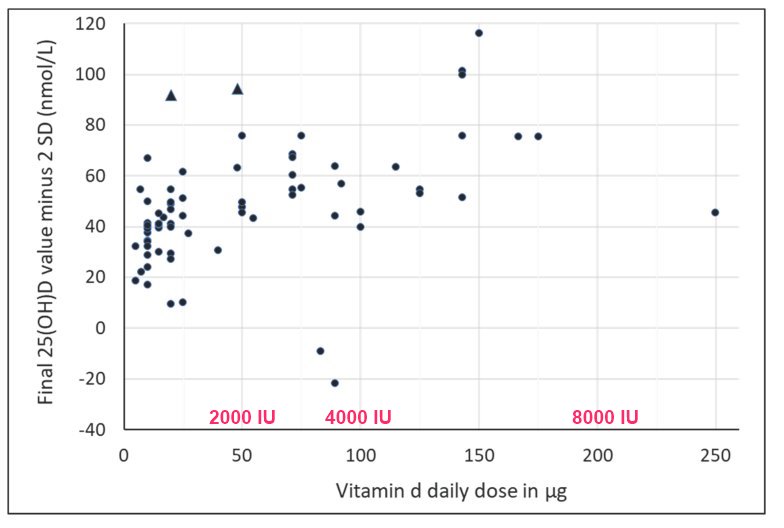1.77 nmol response to 100 IU of Vitamin D (46 RCTs) – meta-analysis
Meta-Analysis of European Clinical Trials Characterizing the Healthy-Adult Serum 25-hydroxyvitamin D Response to Vitamin D Supplementation
Nutrients. 2023 Sep 14;15(18):3986. doi: 10.3390/nu15183986.
Manuel Rupprecht 1 2, Stefan Wagenpfeil 3, Jakob Schöpe 3, Reinhold Vieth 4, Thomas Vogt 1, Jörg Reichrath 1
Clinical Trials

Dose Response - adjusted

Figure 7. Estimation of serum 25(OH)D concentration reasonably assured for adults taking the doses used in European clinical trials of vitamin D supplementation using cholecalciferol (circles) or calcidiol (triangles). The data points shown in this scatter plot each show the values of the mean minus 2 SD for serum 25(OH)D in all vitamin D studies included in this meta-analysis versus the daily doses of vitamin D in those studies. That is, each data point represents the lowest serum 25(OH)D value estimated for the study’s daily dose .
To obtain reliable data that allow health authorities to re-evaluate recommendations for oral vitamin D uptake, we conducted a meta-analysis to investigate the impact of supplementation on serum 25-hydroxyvitamin D (25(OH)D) levels in healthy adults in Europe. Of the publications identified (n = 4005) in our literature search (PUBMED, through 2 January 2022), 49 primary studies (7320 subjects, 73 study arms) were eligible for inclusion in our meta-analysis. The risk of bias was assessed using the Cochrane RoB tool based on seven categories, according to which each study is rated using three grades, and overall was rated as rather low. The median duration of intervention was 136.78 days (range, 1088 days); the mean weighted baseline 25(OH)D concentration and mean age were 33.01 vs. 33.84 nmol/L and 46.8 vs. 44.8 years in the vitamin D and placebo groups, respectively. Using random-effects models, 25(OH)D levels were increased by 36.28 nmol/L (95% CI 31.97-40.59) in the vitamin D group compared to the placebo, with a relative serum increment of 1.77 nmol/L per 2.5 μg of vitamin D daily. Notably, the relative serum 25(OH)D increment was affected by various factors, including the dosage and baseline serum 25(OH)D concentration, decreasing with increasing vitamin D doses and with increasing baseline serum levels. We estimate that supplementation in all healthy adults in Europe with appr. 25 μg of vitamin D (1000 IU) daily would raise serum 25(OH)D levels in 95% of the population to ≥50 nmol/L. Our work provides health authorities with reliable data that can help to re-evaluate recommendations for oral vitamin D supplementation.
📄 Download the PDF from Vitamin D Life
1,000 IU should raise most European adults to >50 nmol/L (20 ng/mL)
See also Vitamin D Life
2700 IU of vitamin D needed to get above 20 ng if dark-skinned and high latitude – Oct 2021
Vitamin D RDA of 600 IU is not enough - global RCT meta-analysis March 2019
171+ Vitamin D Life pages with RESPONSE OR RESPONDER
This list is automatically updated
{LIST()}
